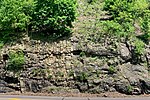Tussey Mountain (ski resort)
Tussey Mountain is a ski resort and all-seasons recreation area located in Boalsburg, Centre County, Pennsylvania, near State College and Penn State University and is the gateway to the Rothrock State Forest. Tussey Mountain includes the Tussey Mountain Amphitheater for concerts and festivals, a Lodge for weddings and parties, and a Fun Centre that offers go-karts, mini-golf, batting cages, a skate park, driving range and a par 3 golf course. Discounted rates are offered for students of Penn State University. In the winter season, Tussey Mountain has 14 trails, with the longest one being about 3/4 of a mile. The top elevation at Tussey Mountain is 1,819 feet (554 m), and there are 38 acres (150,000 m2) skiable at the Tussey Mountain Ski Area.
Excerpt from the Wikipedia article Tussey Mountain (ski resort) (License: CC BY-SA 3.0, Authors).Tussey Mountain (ski resort)
Bear Meadows Road,
Geographical coordinates (GPS) Address Nearby Places Show on map
Geographical coordinates (GPS)
| Latitude | Longitude |
|---|---|
| N 40.7682 ° | E -77.752 ° |
Address
Bear Meadows Road
16827
Pennsylvania, United States
Open on Google Maps










